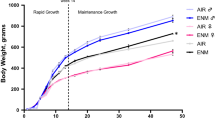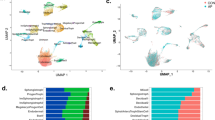Abstract
The increasing use of nanomaterials has raised concerns about their potential risks to human health. Recent studies have shown that nanoparticles can cross the placenta barrier in pregnant mice and cause neurotoxicity in their offspring, but a more detailed understanding of the effects of nanoparticles on pregnant animals remains elusive. Here, we show that silica and titanium dioxide nanoparticles with diameters of 70 nm and 35 nm, respectively, can cause pregnancy complications when injected intravenously into pregnant mice. The silica and titanium dioxide nanoparticles were found in the placenta, fetal liver and fetal brain. Mice treated with these nanoparticles had smaller uteri and smaller fetuses than untreated controls. Fullerene molecules and larger (300 and 1,000 nm) silica particles did not induce these complications. These detrimental effects are linked to structural and functional abnormalities in the placenta on the maternal side, and are abolished when the surfaces of the silica nanoparticles are modified with carboxyl and amine groups.
This is a preview of subscription content, access via your institution
Access options
Subscribe to this journal
Receive 12 print issues and online access
$259.00 per year
only $21.58 per issue
Buy this article
- Purchase on Springer Link
- Instant access to full article PDF
Prices may be subject to local taxes which are calculated during checkout





Similar content being viewed by others
References
Konstantatos, G. & Sargent, E. H. Nanostructured materials for photon detection. Nature Nanotech. 5, 391–400 (2010).
Augustin, M. A. & Sanguansri, P. Nanostructured materials in the food industry. Adv. Food. Nutr. Res. 58, 183–213 (2009).
Bowman, D. M., van Calster, G. & Friedrichs, S. Nanomaterials and regulation of cosmetics. Nature Nanotech. 5, 92 (2010).
Petros, R. A. & DeSimone, J. M. Strategies in the design of nanoparticles for therapeutic applications. Nature Rev. Drug Discov. 9, 615–627 (2010).
Martin, K. R. The chemistry of silica and its potential health benefits. J. Nutr. Health Aging. 11, 94–97 (2007).
Knopp, D., Tang, D. & Niessner, R. Review: bioanalytical applications of biomolecule-functionalized nanometer-sized doped silica particles. Anal. Chim. Acta. 647, 14–30 (2009).
Kagan, V. E., Bayir, H. & Shvedova, A. A. Nanomedicine and nanotoxicology: two sides of the same coin. Nanomedicine 1, 313–316 (2005).
Nel, A., Xia, T., Madler, L. & Li, N. Toxic potential of materials at the nanolevel. Science 311, 622–627 (2006).
Fadeel, B. & Garcia-Bennett, A. E. Better safe than sorry: understanding the toxicological properties of inorganic nanoparticles manufactured for biomedical applications. Adv. Drug. Deliv. Rev. 62, 362–374 (2010).
Poland, C. A. et al. Carbon nanotubes introduced into the abdominal cavity of mice show asbestos-like pathogenicity in a pilot study. Nature Nanotech. 3, 423–428 (2008).
Donaldson, K., Murphy, F. A., Duffin, R. & Poland, C. A. Asbestos, carbon nanotubes and the pleural mesothelium: a review of the hypothesis regarding the role of long fibre retention in the parietal pleura, inflammation and mesothelioma. Part. Fibre Toxicol. 7, 5 (2010).
Nabeshi, H. et al. Systemic distribution, nuclear entry and cytotoxicity of amorphous nanosilica following topical application. Biomaterials 32, 2713–2724 (2011).
Nabeshi, H. et al. Amorphous nanosilica induce endocytosis-dependent ROS generation and DNA damage in human keratinocytes. Part. Fibre Toxicol. 8, 1 (2011).
Koren, G., Pastuszak, A. & Ito, S. Drugs in pregnancy. N. Engl. J. Med. 338, 1128–1137 (1998).
Tardiff, R. G., Carson, M. L. & Ginevan, M. E. Updated weight of evidence for an association between adverse reproductive and developmental effects and exposure to disinfection by-products. Regul. Toxicol. Pharmacol. 45, 185–205 (2006).
Wigle, D. T. et al. Epidemiologic evidence of relationships between reproductive and child health outcomes and environmental chemical contaminants. J. Toxicol. Environ. Health. B. Crit. Rev. 11, 373–517 (2008).
Mills, J. L. et al. Incidence of spontaneous abortion among normal women and insulin-dependent diabetic women whose pregnancies were identified within 21 days of conception. N. Engl. J. Med. 319, 1617–1623 (1988).
Cetin, I. & Alvino, G. Intrauterine growth restriction: implications for placental metabolism and transport. A review. Placenta 30(Suppl. A), S77–S82 (2009).
Godfrey, K. M. & Barker, D. J. Fetal nutrition and adult disease. Am. J. Clin. Nutr. 71, 1344S–1352S (2000).
Barker, D. J. Adult consequences of fetal growth restriction. Clin. Obstet. Gynecol. 49, 270–283 (2006).
Takeda, K. et al. Nanoparticles transferred from pregnant mice to their offspring can damage the genital and cranial nerve systems. J. Health Sci. 55, 95–102 (2009).
Shimizu, M. et al. Maternal exposure to nanoparticulate titanium dioxide during the prenatal period alters gene expression related to brain development in the mouse. Part. Fibre Toxicol. 6, 20 (2009).
Tian, F. et al. Surface modification and size dependence in particle translocation during early embryonic development. Inhal. Toxicol. 21(Suppl. 1), 92–96 (2009).
Saunders, M. Transplacental transport of nanomaterials. Wiley Interdiscip. Rev. Nanomed. Nanobiotechnol. 1, 671–684 (2009).
Chu, M. et al. Transfer of quantum dots from pregnant mice to pups across the placental barrier. Small 6, 670–678 (2010).
Hougaard, K. S. et al. Effects of prenatal exposure to surface-coated nanosized titanium dioxide (UV-Titan). A study in mice. Part. Fibre Toxicol. 7, 16 (2010).
He, X. et al. In vivo study of biodistribution and urinary excretion of surface-modified silica nanoparticles. Anal. Chem. 80, 9597–9603 (2008).
Wick, P. et al. Barrier capacity of human placenta for nanosized materials. Environ. Health Perspect. 118, 432–436 (2010).
Watson, R. E., Desesso, J. M., Hurtt, M. E. & Cappon, G. D. Postnatal growth and morphological development of the brain: a species comparison. Birth Defects Res. B. Dev. Reprod. Toxicol. 77, 471–484 (2006).
Li, L. et al. In vivo delivery of silica nanorattle encapsulated docetaxel for liver cancer therapy with low toxicity and high efficacy. ACS Nano. 4, 6874–6882 (2010).
Filipe, P. et al. Stratum corneum is an effective barrier to TiO2 and ZnO nanoparticle percutaneous absorption. Skin Pharmacol. Physiol. 22, 266–275 (2009).
Sadrieh, N. et al. Lack of significant dermal penetration of titanium dioxide from sunscreen formulations containing nano- and submicron-size TiO2 particles. Toxicol. Sci. 115, 156–166 (2010).
Albrecht, C. et al. Inflammatory time course after quartz instillation: role of tumor necrosis factor-alpha and particle surface. Am. J. Respir. Cell. Mol. Biol. 31, 292–301 (2004).
Kibschull, M., Gellhaus, A. & Winterhager, E. Analogous and unique functions of connexins in mouse and human placental development. Placenta 29, 848–854 (2008).
Gasperowicz, M. & Otto, F. The notch signalling pathway in the development of the mouse placenta. Placenta 29, 651–659 (2008).
Lam, C., Lim, K. H. & Karumanchi, S. A. Circulating angiogenic factors in the pathogenesis and prediction of preeclampsia. Hypertension 46, 1077–1085 (2005).
Hirashima, M., Lu, Y., Byers, L. & Rossant, J. Trophoblast expression of fms-like tyrosine kinase 1 is not required for the establishment of the maternal–fetal interface in the mouse placenta. Proc. Natl Acad. Sci. USA 100, 15637–15642 (2003).
Derksen, R. H., Khamashta, M. A. & Branch, D. W. Management of the obstetric antiphospholipid syndrome. Arthritis Rheum. 50, 1028–1039 (2004).
Li, Y., Wang, H. Y. & Cho, C. H. Association of heparin with basic fibroblast growth factor, epidermal growth factor, and constitutive nitric oxide synthase on healing of gastric ulcer in rats. J. Pharmacol. Exp. Ther. 290, 789–796 (1999).
Girardi, G., Redecha, P. & Salmon, J. E. Heparin prevents antiphospholipid antibody-induced fetal loss by inhibiting complement activation. Nature Med. 10, 1222–1226 (2004).
Hills, F. A. et al. Heparin prevents programmed cell death in human trophoblast. Mol. Hum. Reprod. 12, 237–243 (2006).
Hossain, N., Schatz, F. & Paidas, M. J. Heparin and maternal fetal interface: why should it work to prevent pregnancy complications? Thromb. Res. 124, 653–655 (2009).
Girardi, G., Yarilin, D., Thurman, J. M., Holers, V. M. & Salmon, J. E. Complement activation induces dysregulation of angiogenic factors and causes fetal rejection and growth restriction. J. Exp. Med. 203, 2165–2175 (2006).
Redecha, P., van Rooijen, N., Torry, D. & Girardi, G. Pravastatin prevents miscarriages in mice: role of tissue factor in placental and fetal injury. Blood 113, 4101–4109 (2009).
Myatt, L. & Cui, X. Oxidative stress in the placenta. Histochem. Cell. Biol. 122, 369–382 (2004).
Hussain, S. et al. Oxidative stress and proinflammatory effects of carbon black and titanium dioxide nanoparticles: role of particle surface area and internalized amount. Toxicology 260, 142–149 (2009).
Liu, X. & Sun, J. Endothelial cells dysfunction induced by silica nanoparticles through oxidative stress via JNK/P53 and NF-κB pathways. Biomaterials 31, 8198–8209 (2010).
Lundqvist, M. et al. Nanoparticle size and surface properties determine the protein corona with possible implications for biological impacts. Proc. Natl Acad. Sci. USA 105, 14265–14270 (2008).
Enders, A. C. & Blankenship, T. N. Comparative placental structure. Adv. Drug Deliv. Rev. 38, 3–15 (1999).
Rossant, J. & Cross, J. C. Placental development: lessons from mouse mutants. Nature Rev. Genet. 2, 538–548 (2001).
Acknowledgements
This study was supported in part by Grants-in-Aid for Scientific Research from the Ministry of Education, Culture, Sports, Science and Technology of Japan (MEXT) and from the Japan Society for the Promotion of Science (JSPS) through a Knowledge Cluster Initiative (MEXT). It was also supported by Health Labour Sciences Research Grants from the Ministry of Health, Labour and Welfare of Japan (MHLW), by a Global Environment Research Fund from the Minister of the Environment, and by the Food Safety Commission (Cabinet Office), the Cosmetology Research Foundation, the Smoking Research Foundation and the Takeda Science Foundation.
Author information
Authors and Affiliations
Contributions
K.Y. and Y.Y. designed the study. K.Y., K.H., K.M., Y. Morishita, M.N., T. Yoshida, T.O., H.N., K.N., Y.A., H.K., Y. Monobe and T.I. performed the experiments. K.Y. and Y.Y. collected and analysed the data. K.Y. and Y.Y. wrote the manuscript. H.A., K.S., Y.K., T.M., S.T., N.I., I.Y., S.S. and T. Yoshikawa provided technical support and conceptual advice. Y.T. supervised the project. All authors discussed the results and commented on the manuscript.
Corresponding authors
Ethics declarations
Competing interests
The authors declare no competing financial interests.
Supplementary information
Supplementary information
Supplementary information (PDF 559 kb)
Rights and permissions
About this article
Cite this article
Yamashita, K., Yoshioka, Y., Higashisaka, K. et al. Silica and titanium dioxide nanoparticles cause pregnancy complications in mice. Nature Nanotech 6, 321–328 (2011). https://doi.org/10.1038/nnano.2011.41
Received:
Accepted:
Published:
Issue Date:
DOI: https://doi.org/10.1038/nnano.2011.41
This article is cited by
-
Silica Nanoparticles Decrease Glutamate Uptake in Blood–Brain Barrier Components
Neurotoxicity Research (2024)
-
Placental transfer and hazards of silver nanoparticles exposure during pregnancy: a review
Environmental Chemistry Letters (2024)
-
Decidual derived exosomal miR-99a-5p targets Ppp2r5a to inhibit trophoblast invasion in response to CeO2NPs exposure
Particle and Fibre Toxicology (2023)
-
Silica nanoparticles induce ovarian granulosa cell apoptosis via activation of the PERK-ATF4-CHOP-ERO1α pathway-mediated IP3R1-dependent calcium mobilization
Cell Biology and Toxicology (2023)
-
Silicified Microorganisms and Microorganism-Like Particles in the Groundwater of an Abandoned Coal Mine
Mine Water and the Environment (2023)



